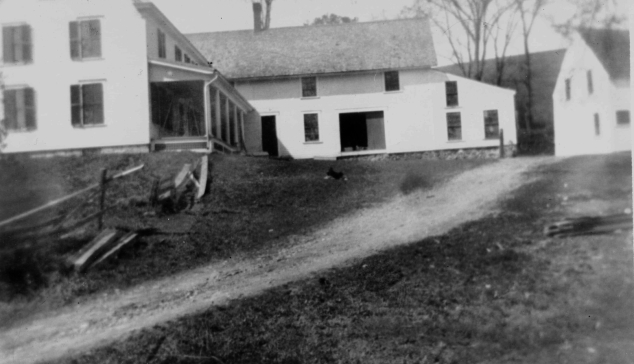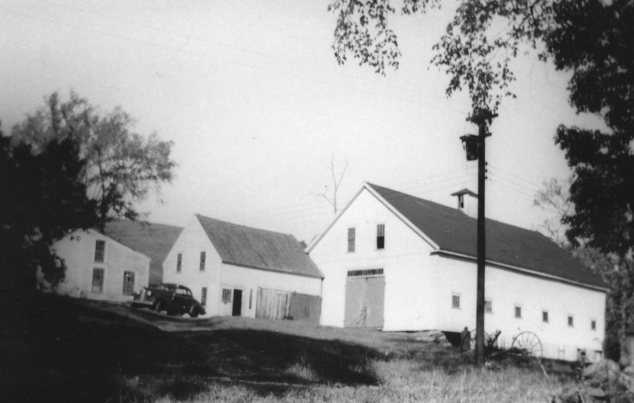
It’s impossible to leave Hoyt Road without telling the story of the Emery family. The Emerys were early settlers on Hoyt Road whose land abutted that of the Kenistons and Hoyts. This article will begin with a look at Emery family history and genealogy, followed by glimpses of the family, their farm, and their sawmill business, as told by Eva Emery.
The Emerys were neighbors and friends of my parents, and I will relate a few Emery stories which I remember hearing from my mother. Much of the information for this article was obtained from a 1986 taped interview with Eva Emery, conducted by Bill Leber, then president of the Andover Historical Society, and from letters written in 1987 and 1988 by Eva Emery to Ginny Newton, who has lived in one of the two Emery houses since the 1970s.

Emery History and Genealogy
Dr. Anthony Emery (1713-1791) was one of the original proprietors of the town’s land grant. Because of his interest in the settlement of this territory, it was once referred to as Emerystown.
Captais William Emery (1742-1825) – Anthony’s son – bought several lots from his father in 1765 and settled in Flaghole. He was the fourth or fifth person to settle here, and the first Emery. His initial dwelling was small, but he later constructed a large framed house which still stands today off Chase Hill Road.
Henry Emery (1788-1849) – William’s youngest son – was the first Emery to settle on Hoyt Road (then Center Road), building a house for his bride Joanna in 1813.
Willard Andrew (1821-1883) – son of Henry – carried on with the farm after his father was killed by a train at Dyers Crossing.
Henry Levi (1857-1937) – son of Willard – took over the farm from his father.
Jay Emery (1891-1976) – son of Henry Levi – was the next owner of the farm.
Dexter Emery (1918-1964) and Rodney Emery (1920-1984) – sons of Jay and Eva – were the last Emerys to own the property.
Early Years at the Emery Farm
When the Emerys received the grant for what became the Emery Farm, a log cabin was built where the big house now sits. The cabin was later torn down and another house built on its foundation.
When Mrs. Henry L. Emery inherited a fairly large sum of money, she used it to build what is now the main house or the “big” house. The “little” house was moved across the road by her son Jay, with a pair of oxen doing the moving. It is currently the home of Ginny Newton.
The new house was built from lumber cut on the Emery farm and sawed at the family’s mill. Only the best was used! The house was furnished beautifully, as there were many Emery family antiques. Wealthy Massachusetts cousins came to the farm often and brought all sorts of beautiful things.
The house was spacious, containing 14 rooms, including a maid’s room and two big rooms for the hired men. Everyone loved the farm! Friends and relatives came and went all of the time, with many staying the whole summer. There was never a dull moment, and there was always room for everybody!
Jay and Eva Emery
Jay Emery and Eva Hackett were married in 1917 and lived briefly with Jay’s parents while the “little” house was being remodeled for them. When completed, Jay and Eva made it their home for 20 years, all the while helping Jay’s parents with the running of the farm.
Their son Dexter was born in 1918, followed by Rodney in 1920. Sadly, their daughter Priscilla died shortly after birth in 1922. It had been a difficult pregnancy, and my mother, Dorothy Hersey, worked as a live-in mother’s helper for Eva during that time.
Dexter and Rodney Emery attended Dyers Crossing School. Marie Nelson (later Rising) was one of Rodney’s teachers, and she had a funny, but scary story to tell concerning him. It was relayed to my sister, Helen Duchesne, when she was writing her book In Their Time.
Marie, who had been Helen’s first grade teacher, told this story: “One day, lightning struck the tree outside the school and came in on the stove vent. The room was blue and smelled of sulphur. Rodney Emery, who sat in the back seat, swore and said, ‘I’m getting out of here.’ He opened the window, jumped out, and ran for home. Marie closed the window and watched him as long as she could, worrying the whole time that he might be struck by lightning.” It certainly wasn’t easy being a teacher in a one-room school!
The Farm and Its Busy Life
Eva Emery described life on the farm:
“We had lilacs and forsythia bushes and a beautiful rose garden. There was a big rhubarb patch by the long hen house, where a little brook ran under the stone wall. There was a big rhubarb patch, and in the spring we had all sorts of things made with rhubarb.
“The horseradish tasted good with beans and red flannel hash, and I used some in my piccalilli. I made beet relish and all kinds of pickles.
“We had some nice elderberry bushes, and I made elderberry wine. There were big strawberry beds, and beyond that a bed of asparagus. When the strawberries were ripe, we picked them in 10-quart pails. There were quince bushes and currant bushes which I used for making jelly. I also made mint jelly from the mint beds.
“There were no trees behind the big house at that time. It was all mowing land. All the trees were on the other side of the road [now Ginny’s property], and that is where the fruit trees were – apple, pear, peach, and crab-apple.
“There were many different kinds of apples – the older varieties, such as Baldwin, Russet, Delicious, Gilliflower or Sheepnose. Jay used to graft new scions every year – McIntosh and many others whose names I now forget.
“Mother Emery used to make cottage cheese. She made a big milk pan full once a week, and it went to one of the restaurants in Franklin. She always had some on the table, and it went as fast as she could make it.
“We also made regular cheese, and Mother had everything needed to make it – from the cheese pails to the presses. We used to make it in two-, five-, and sometimes 10-pound molds. Grampa Emery loved cheese, and he never could wait for it to ripen before eating it!
“We always had a big garden and a couple of hired hands to look after it. I canned and canned and canned! During planting, haying, and harvesting times, we had lots of extra help, and that was a busy time.
“We had an ice house in the back of the shed, and Jay cut the ice to fill it. When the men came in from the fields, we had a big, cold pitcher of lemonade ready for them. We had four- and six-quart ice cream freezers which were full of ice cream that I made for them to have in the evening.
“We had a whole big barn full of cows and lots of cream and milk. I used to make as much as 50 pounds of butter a week. Grandpa had his regular customers, and a lot of the butter went to Shepard Grocery.”
Watch for more about the Emerys in a future article.